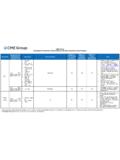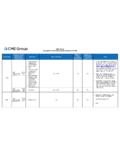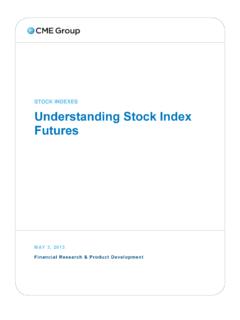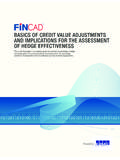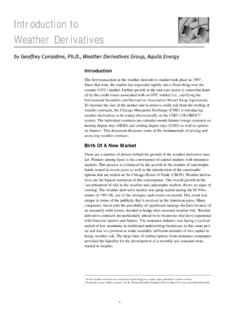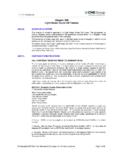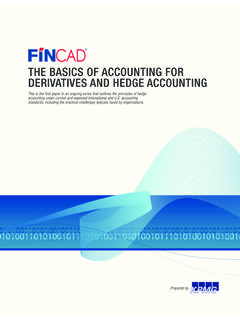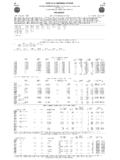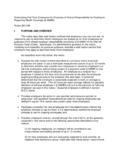Transcription of MARKET REGULATION ADVISORY NOTICE - cmegroup.com
1 MARKET REGULATION ADVISORY NOTICE _____ Exchange CME, CBOT, NYMEX & COMEX Subject Exchange for Related Positions Rule References Rule 538 ADVISORY Date September 20, 2016 ADVISORY Number CME Group RA1612-5 Revised Effective Date October 4, 2016 Effective on trade date October 4, 2016, and pending all relevant CFTC regulatory review periods, this ADVISORY NOTICE will supersede CME Group MARKET REGULATION ADVISORY NOTICE RA1311-5RR from June 27, 2014. It is being issued as a result of several changes to the text of Rule 538 ( Exchange for Related Positions ) and the associated regulatory guidance contained in this ADVISORY NOTICE . The text of amended Rule 538 begins on page 3 of this ADVISORY NOTICE . The changes to the Rule and regulatory guidance contained in the ADVISORY NOTICE include the following: Allowing a non-transitory EFRP to contain multiple Exchange components, eliminating the requirement that such Exchange components have the same MARKET bias; Allowing a third party to facilitate, as principal, the related position component of an EFRP, eliminating the requirement that such parties be member firms; Modifying the requirements with respect to CTAs or other account controllers facilitating immediately offsetting foreign currency EFPs; Clarifying the responsibility of firms executing or clearing EFRPs on behalf of customers; Clarifying that the related position component of an EOO must be an OTC option; Modifying submission time requirements for EFRPs to CME Clearing.
2 Clarifying that all underlying account statements are required to uniquely identify EFRP transactions; Clarifying that the facilitation of the execution of a non-bona fide EFRP by any party constitutes a violation of the Rule; and Eliminating the use of summary fines pursuant to Rule 512 for failure to provide requested records to MARKET REGULATION in a complete and timely manner. MARKET participants should note that no changes have been made with respect to the continued prohibition on the execution of transitory EFRPs in any products. CME Group RA1612-5 September 20, 2016 Page 2 of 14 The execution of transitory EFRPs, which prior to August 4, 2014 had been permitted in CME foreign currency products, NYMEX energy products and COMEX and NYMEX metals products remain strictly prohibited. As defined in Rule 538, transitory EFRPs are EFRPs in which the execution of an EFRP is contingent upon the execution of another EFRP or related position transaction between the parties and where the transactions result in the offset of the related positions without the incurrence of MARKET risk that is material in the context of the related position transactions.
3 Questions 13-16 in the FAQ provide additional guidance in this regard. The time period between the transactions is a factor considered in assessing whether the EFRP is a transitory EFRP; however, the legitimacy of the transactions will be evaluated based on whether the transactions have integrity as independent transactions exposed to MARKET risk that is material in the context of the transactions. Questions regarding this ADVISORY NOTICE may be directed to the following individuals in MARKET REGULATION : For NYMEX and COMEX Products For CME and CBOT Products Tom Dixon, Manager, Brian Babinski, Lead Analyst, Ryne Toscano, Director, Michael Joubert, Specialist, William Lange, Director, Chris Reinhardt, Senior Director, For media inquiries concerning this ADVISORY NOTICE , please contact CME Group Corporate Communications at or CME Group RA1612-5 September 20, 2016 Page 3 of 14 Text of Amended Rule 538 ( Exchange for Related Positions ) An Exchange for Related Position ( EFRP )
4 Transaction involves a privately negotiated off-exchange execution of an Exchange futures or options contract and, on the opposite side of the MARKET , the simultaneous execution of an equivalent quantity of the cash product, by-product, related product, or OTC derivative instrument corresponding to the asset underlying the Exchange contract. The following types of EFRP transactions are permitted to be executed outside of the Exchange s centralized MARKET in accordance with the requirements of this rule: Exchange of Futures for Physical ( EFP ) the simultaneous execution of an Exchange futures contract and a corresponding physical transaction or a forward contract on a physical transaction. Exchange of Futures for Risk ( EFR ) the simultaneous execution of an Exchange futures contract and a corresponding OTC swap or other OTC derivative transaction.
5 Exchange of Option for Option ( EOO ) the simultaneous execution of an Exchange option contract and a corresponding transaction in an OTC option. For purposes of this rule, EFPs, EFRs and EOOs shall collectively be referred to as EFRP transactions. Parties to an EFRP One party to the EFRP must be the buyer of the Exchange contract and the seller of (or the holder of the short MARKET exposure associated with) the related position; the other party to the EFRP must be the seller of the Exchange contract and the buyer of (or the holder of the long MARKET exposure associated with) the related position. The Exchange contract and the corresponding related position must be executed for accounts with the same beneficial ownership. A third party may facilitate, as principal, the related position component of an EFRP on behalf of a customer.
6 Except for immediately offsetting foreign currency EFPs executed pursuant to Section K., such third party must be able to demonstrate that the related position was passed through to the customer who received the Exchange contract as part of the EFRP. Specifically with respect to the execution of immediately offsetting foreign currency EFPs pursuant to Section K. by CTAs, account controllers, or other Persons acting on behalf of another party, the initiating and offsetting cash legs are not required to be passed through to the customer who received the Exchange contract as part of the EFRP. However, in a circumstance where the futures leg of the transaction fails to clear, the underlying customer must receive the profit or loss, if any, attendant to the offset of the offsetting cash leg. Parties to an EFR or EOO transaction must comply with all relevant CFTC regulations governing eligibility to participate in the related position component of such transactions.
7 Independently Controlled Accounts The opposing accounts to an EFRP transaction must be (a) independently controlled accounts with different beneficial ownership; (b) independently controlled accounts of separate legal entities with common beneficial ownership; or (c) independently controlled accounts of the same legal entity, provided that the account controllers operate in separate business units. For EFRP transactions between accounts with common beneficial ownership, the parties to the trade must be able to demonstrate the independent control of the accounts and that the transaction had economic substance for each party to the trade. CME Group RA1612-5 September 20, 2016 Page 4 of 14 Related Position The related position component of an EFRP must be the cash commodity underlying the Exchange contract or a by-product, a related product or an OTC derivative instrument of such commodity that has a reasonable degree of price correlation to the commodity underlying the Exchange contract.
8 The related position component of an EFRP may not be a futures contract or an option on a futures contract. Each EFRP requires a bona fide transfer of ownership of the underlying asset between the parties or a bona fide, legally binding contract between the parties consistent with relevant MARKET conventions for the particular related position transaction. The execution of an EFRP transaction may not be contingent upon the execution of another EFRP or related position transaction between the parties where the transactions result in the offset of the related position without the incurrence of MARKET risk that is material in the context of the related position transactions. The facilitation of the execution of an EFRP by any party that knows such EFRP is non bona fide shall constitute a violation of this Rule.
9 EFPs in Connection with Inventory Financing of Storable, Non-Financial Commodities A party providing inventory financing for a storable agricultural, energy or metals commodity may, through the execution of an EFP, purchase the commodity and sell the equivalent quantity of futures contracts to a counterparty, and grant to the counterparty the non-transferable right, but not the obligation, to execute a second EFP during a specified time period in the future which will have the effect of reversing the original EFP. Quantity Equivalence The quantity of the related position component of the EFRP must be approximately equivalent to the quantity of the Exchange component of the EFRP. Appropriate hedge ratios between the Exchange and related position components of the EFRP may be used to establish equivalency. Prices and Price Increments The Exchange component of the EFRP transaction must be priced in accordance with the applicable futures price increments or option premium increments as set forth in the rules governing the Exchange contract.
10 EFRPs may be transacted at such commercially reasonable prices as are mutually agreed upon by the parties to the transaction. EFRPs may not be priced to facilitate the transfer of funds between parties for any purpose other than as the consequence of legitimate commercial activity. EFRPs Following the Termination of Trading in Exchange Contracts EFRP transactions in certain Exchange contracts may be executed for a defined period of time following the termination of trading in accordance with the applicable product rules governing each Exchange contract. Such transactions may be executed only to liquidate Exchange positions. Recordkeeping Parties to an EFRP transaction must maintain all records relevant to the Exchange contract and the related position transaction, including order tickets, records customarily generated in accordance with relevant MARKET practices, records reflecting payments between the parties and, where appropriate, transfer of title, as well as any other records required to be kept pursuant to CFTC REGULATION CME Group RA1612-5 September 20, 2016 Page 5 of 14 Brokers who facilitate EFRP transactions must maintain all records corresponding to their facilitation of the transactions.
